Japanese food

Japanese food |
 |
Gastronomy in Japan |
TOP > Japanese food
Japanese Food Japanese food is very varied. We introduce the food and the cooking method from all over the world. We arrange the foreign food into Japanese food such as curry and ramen. I think there is no other country than Japan where you can enjoy the world cuisine casually at home and at restaurant. I introduce typical Japanese food here. The characteristics of Japanese food are as follows. - Value on the apperance - Light seasoning basically by soy sauce - Use chopstics when you eat Sushi  Make the vinegared rice in round shape, and put the thinly sliced raw fish or shellfish on it. Put a little horseradish between rice and fish. Dank lightly in soy sauce before eating. Some sushi restaurants are very expensive but you can find low price 'Kaiten-zushi (belt-conveyor sushi resutaurant)'. Sashimi (raw sea food)  Thinly sliced raw fish and shellfish. It is same as the topping of sushi, but it is served without rice ball. We call it 'Sashimi'. Put some horseradish and dank lightly in soy sauce before eating. Tempura 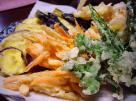 Put deep fry batter made of wheat flour and egg on shrimps, squids or thinly sliced vegetables. Then fry in oil. Dank in soy sauce based 'tentsuyu' added grated radish before eating. If you put several tempura on rice and pour tentsuyu, it is called 'Tendon' Sukiyaki 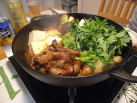 Skiyaki is a kind of beef stew. Thinly sliced beef, tofu (bean curd), shirataki (elephant foot), leek, chinese cabbage, etc are put in the pan and boiled with the soup made by soy sauce, sweet cooking rice wine and sake. Normally it is eaten after dunked in the stirred egg. Shabushabu 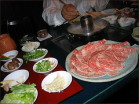 Dunk and heat thinly sliced beef in the boiling soup in the pan. After you heat the beef, dunk in the sauce mad by sesami or vinegar and soy sauce. Other than beef, tofu and vegetables like leek and chinese cabbage are boiled toghether. Soba 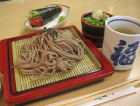 Brownish noodles made from buckwheat flour (usually wheat flour is also added). The noodle is boiled and put in the hot soup made by mainly soy sauce (called Kakesoba or other kinds). Or cool it with the water and dunk in the cold soup before eating (called Zarusoba or Morisoba). Udon 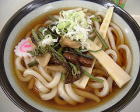 White thick noodels made from wheat flour. The noodle is boiled and put in the hot soup made by mainly soy sauce (called Kakeudon or other kinds). Or cool it with the water and dunk in the cold soup before eating (called Zaruudon or Moriudon). Ramen  Chinese style noodles made from wheat flour and brine. The noodle is boiled and put in the hot soup. The taste of soup are varied. For example, soy sauce taste, miso (soybean paste) taste or salt taste. This is the example that we arrange Chinese food into japanese food. Yakitori (skewered grilled chicken) 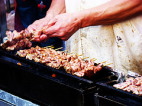 Thread small cut chicken (and sometimes vegetables) onto the skewer. Then broiled over a charcoal fire. Then dip in the special sweet soy sauce or season with salt. Oden  Boil Radish, fish sausage, konnyaku (elephant foot), egg, Kombu (kelp), fried tofu (bean curd) in the sauce seasoned with mainly soy sauce. It is so to speak, Japanese Pot-au-feu. Okonomiyaki (Japanese pizza) 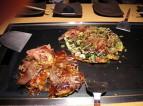 Mix sea food, meat, vegetables, pickled ginger etc, with the dough made from wheat flour and water. Then cook flatly on the iron plate. Brush thick sauce before eating. There are similar food called Monjayaki (put more water in the dough and mix with the sauce before cooking) and Modanyaki (cook needles toghether) Natto 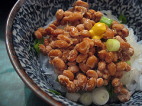 Cover the steamed soybean with straw and ferment. After stirring well, mix with special sauce, leek and mustard. Then put on the rice. It is very rich in nutrition. Umeboshi 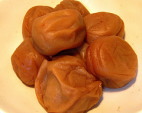 Umeboshi is a pickled plum. Pickled in the salt and dried in the sun. It is used as filling of rice ball or put in the middle of rice of the box lunch. It is very sour. Kaiseki-ryori 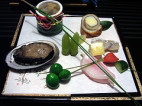 There are two types of Kaiseki-ryori. The pronunciation is same but if you write in Chinese character, they are different. The one is the food to enjoy tea and served in the manner of tea ceremony. The other one is the food to enjoy sake (rice wine). In both cases, many small portion food will be served one by one. They are for example, appetizer, boiled dish, grilled dish, soup, rice and sweets. Shojin-ryori 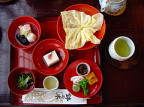 It is a vegetarian dish for Buddhist monks. They don't eat meat nor fish because the Buddhism prohibits killing animals and fish. Drink  Sake: Rice wine. Typical Japanese alcohol drink. You can taste it is served either chilled or heated. Shochu: Distilled alcohol made from rice, potato, etc. Green tea: The most popular tea in Japan. Heat the picked leaf to prevent fermentation. |
 Beautiful and delicate Japanese sweets |
| Copyright(C) Let's Travel in Japan! All Rights Reserved |